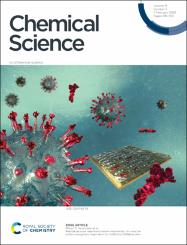| dc.contributor.author | Yarman, Aysu | |
| dc.contributor.author | Bognar, Zso´fia | |
| dc.contributor.author | Supala, Eszter | |
| dc.contributor.author | Zhang, Xiaorong | |
| dc.contributor.author | Bier, Frank F. | |
| dc.contributor.author | Scheller, Frieder W. | |
| dc.contributor.author | Gyurcsanyi, Robert E. | |
| dc.date.accessioned | 2024-04-24T18:05:50Z | |
| dc.date.available | 2024-04-24T18:05:50Z | |
| dc.date.issued | 2022 | en_US |
| dc.identifier.citation | Yarman, A., Bognar, Zso´f., :Supala, E., Zhang, X., Bier, Frank F., Scheller, Frieder W., Gyurcsanyi, Robert E. (2022). Peptide epitope-imprinted polymer microarrays for selective protein recognition. Application for SARSCoV-2 RBD protein. Chemical Science, 13 (5), 1181-1514. | en_US |
| dc.identifier.uri | https://hdl.handle.net/20.500.12846/1148 | |
| dc.description.abstract | We introduce a practically generic approach for the generation of epitope-imprinted polymer-based
microarrays for protein recognition on surface plasmon resonance imaging (SPRi) chips. The SPRi
platform allows the subsequent rapid screening of target binding kinetics in a multiplexed and label-free
manner. The versatility of such microarrays, both as synthetic and screening platform, is demonstrated
through developing highly affine molecularly imprinted polymers (MIPs) for the recognition of the
receptor binding domain (RBD) of SARS-CoV-2 spike protein. A characteristic nonapeptide GFNCYFPLQ
from the RBD and other control peptides were microspotted onto gold SPRi chips followed by the
electrosynthesis of a polyscopoletin nanofilm to generate in one step MIP arrays. A single chip screening
of essential synthesis parameters, including the surface density of the template peptide and its sequence
led to MIPs with dissociation constants (KD) in the lower nanomolar range for RBD, which exceeds the
affinity of RBD for its natural target, angiotensin-convertase 2 enzyme. Remarkably, the same MIPs
bound SARS-CoV-2 virus like particles with even higher affinity along with excellent discrimination of
influenza A (H3N2) virus. While MIPs prepared with a truncated heptapeptide template GFNCYFP showed
only a slightly decreased affinity for RBD, a single mismatch in the amino acid sequence of the template,
i.e. the substitution of the central cysteine with a serine, fully suppressed the RBD binding. | en_US |
| dc.language.iso | eng | en_US |
| dc.relation.isversionof | 10.1039/d1sc04502d | en_US |
| dc.rights | info:eu-repo/semantics/openAccess | en_US |
| dc.title | Peptide epitope-imprinted polymer microarrays for selective protein recognition. Application for SARSCoV-2 RBD protein | en_US |
| dc.type | article | en_US |
| dc.relation.journal | Chemical Science | en_US |
| dc.identifier.volume | 13 | en_US |
| dc.identifier.issue | 5 | en_US |
| dc.relation.publicationcategory | Makale - Uluslararası Hakemli Dergi - Kurum Öğretim Elemanı | en_US |
| dc.contributor.department | TAÜ, Fen Fakültesi, Moleküler Biyoteknoloji Bölümü | en_US |
| dc.identifier.startpage | 1181 | en_US |
| dc.identifier.endpage | 1514 | en_US |

















